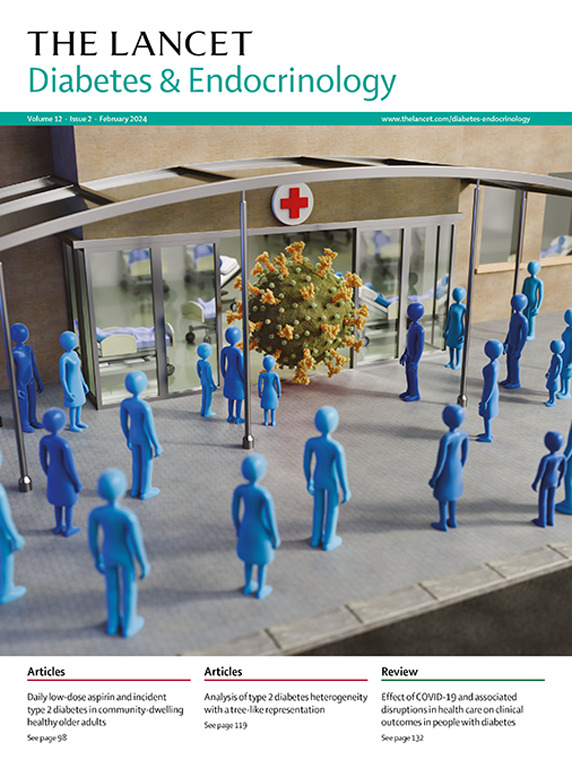Non-autoimmune, insulin-deficient diabetes in children and young adults in Africa: evidence from the Young-Onset Diabetes in sub-Saharan Africa (YODA) cross-sectional study
IF 41.8
1区 医学
Q1 ENDOCRINOLOGY & METABOLISM
引用次数: 0
Abstract
Background
Studies of type 1 diabetes in sub-Saharan Africa have suggested that the clinical phenotype might differ from phenotypes reported elsewhere. We aimed to establish whether type 1 diabetes diagnosed in children and young adults in three countries across sub-Saharan Africa is of autoimmune origin.Methods
In this observational, cross-sectional study, we identified participants without obesity from outpatient clinics in government and private hospitals in Cameroon, Uganda, and South Africa who were of self-reported Black African ethnicity with young-onset (age <30 years), insulin-treated, clinically diagnosed type 1 diabetes. We measured islet autoantibodies to GADA, IA-2A, and ZnT8A, and calculated a genetic risk score (GRS) for type 1 diabetes, which we compared with control populations without diabetes derived from the Uganda Genome Resource databank and other studies. Endogenous insulin secretion was assessed using plasma C-peptide. We compared findings with those for participants with self-reported Black (n=429) and White (n=2602) ancestry with type 1 diabetes from the SEARCH for Diabetes in Youth (SEARCH) study in the USA.Findings
Of 1072 participants identified between Aug 28, 2019, and March 31, 2022 (Cameroon and Uganda), and Oct 3, 2007, to Sept 14, 2015 (South Africa), 894 were included in our analysis (454 [50·8%] were male and 440 [49·2%] were female): 248 participants were from Cameroon, 370 from Uganda, and 276 from South Africa. Participants from sub-Saharan Africa were diagnosed with diabetes at a median age of 15 years (IQR 11–19), with a median diabetes duration of 5 years (2–10), and a BMI of 21·7 kg/m2 (19·5–24·1). Only 312 (34·9%) of 894 participants were positive for islet autoantibodies; these participants had classic features of type 1 diabetes, including 225 (82·7%) of 272 with plasma C-peptide <200 pmol/L, and high type 1 diabetes GRS. Those without islet autoantibodies (582 [65·1%] of 894) had significantly lower median type 1 diabetes GRS than those with autoantibodies (9·66 [IQR 7·77–11·33] vs 11·76 [10·49–12·91]; p<0·0001), suggesting a subgroup with a non-autoimmune diabetes subtype, with clinical features and C-peptide concentrations not consistent with type 2 diabetes. Among participants diagnosed younger than 20 years, autoantibody-negative diabetes was also observed in 65 (15·1%) of 429 participants with Black ancestry in SEARCH (although less frequently than in sub-Saharan Africa [59 (55·1%) of 107]), and these participants also had a low type 1 diabetes GRS (median 10·41 [IQR 8·65–12·22] in autoantibody-negative subgroup). No such pattern was observed in White participants in SEARCH: 241 (9·3%) of 2602 were autoantibody negative and median GRS for type 1 diabetes was similar in autoantibody-negative and autoantibody-positive participants (median 13·42 [IQR 11·80–14·61] vs 13·49 [12·29–14·58]).Interpretation
In sub-Saharan Africa, clinically diagnosed type 1 diabetes is heterogeneous, comprising classic autoimmune type 1 diabetes and a novel, non-autoimmune, insulin-deficient diabetes subtype. There is evidence of this subtype in Black but not White individuals in the USA. Therefore, alternative causes must be considered in this group of individuals, and understanding the drivers of this subtype might offer new insights into prevention and treatment.Funding
UK National Institute of Health and Care Research.Translation
For the French translation of the abstract see Supplementary Materials section.非洲儿童和年轻人的非自身免疫性胰岛素缺乏性糖尿病:来自撒哈拉以南非洲年轻发病糖尿病横断面研究的证据
背景:撒哈拉以南非洲1型糖尿病的研究表明,临床表型可能与其他地方报道的表型不同。我们的目的是确定在撒哈拉以南非洲三个国家的儿童和年轻人中诊断出的1型糖尿病是否是自身免疫性的起源。方法在这项观察性横断面研究中,我们从喀麦隆、乌干达和南非的政府和私立医院的门诊诊所中找到了没有肥胖的参与者,这些参与者自述为非洲黑人,发病年轻(年龄30岁),接受胰岛素治疗,临床诊断为1型糖尿病。我们测量了针对GADA、IA-2A和ZnT8A的胰岛自身抗体,并计算了1型糖尿病的遗传风险评分(GRS),并将其与来自乌干达基因组资源数据库和其他研究的无糖尿病对照人群进行了比较。血浆c肽测定内源性胰岛素分泌。我们将研究结果与来自美国SEARCH for diabetes in Youth (SEARCH)研究中自我报告患有1型糖尿病的黑人(n=429)和白人(n=2602)祖先的研究结果进行了比较。在2019年8月28日至2022年3月31日(喀麦隆和乌干达)以及2007年10月3日至2015年9月14日(南非)期间确定的1072名参与者中,894人被纳入我们的分析(454人[50.8%]为男性,440人[49.2%]为女性):248名参与者来自喀麦隆,370名来自乌干达,276名来自南非。来自撒哈拉以南非洲的参与者被诊断为糖尿病,平均年龄为15岁(IQR 11-19),平均糖尿病病程为5年(2-10),BMI为21.7 kg/m2(19.5 - 24.1)。894名参与者中只有312人(34.9%)的胰岛自身抗体阳性;这些参与者具有典型的1型糖尿病特征,其中272人中有225人(86.7%)血浆c肽和lt为200 pmol/L,并且1型糖尿病GRS较高。无胰岛自身抗体组(894例中582例[65.1%])的中位1型糖尿病GRS显著低于有自身抗体组(9.66 [IQR: 7.77 - 11.33]比11.76 [10.49 - 12.91];p< 0.0001),提示该亚组为非自身免疫性糖尿病亚型,其临床特征和c肽浓度与2型糖尿病不一致。在被诊断为20岁以下的参与者中,在429名黑人血统参与者中也观察到65名(15.1%)自身抗体阴性糖尿病(尽管低于撒哈拉以南非洲地区的频率[107人中的59人(55.1%)]),这些参与者也具有低1型糖尿病GRS(自身抗体阴性亚组中位数为10.41 [IQR为8.65 - 12.22])。在白人受试者中没有观察到这种模式:2602名受试者中有241名(9.3%)为自身抗体阴性,自身抗体阴性和自身抗体阳性受试者中1型糖尿病的中位GRS相似(中位13.42 [IQR 11.80 - 14.61] vs 13.49 [IQR 12.29 - 14.58])。在撒哈拉以南非洲,临床诊断的1型糖尿病是异质性的,包括经典的自身免疫性1型糖尿病和一种新的非自身免疫性胰岛素缺乏型糖尿病亚型。有证据表明这种亚型在美国黑人中存在,但在白人中没有。因此,在这组个体中必须考虑其他原因,了解这一亚型的驱动因素可能为预防和治疗提供新的见解。资助英国国家健康和护理研究所。摘要的法文译本见补充资料部分。
本文章由计算机程序翻译,如有差异,请以英文原文为准。
求助全文
约1分钟内获得全文
求助全文
来源期刊

The Lancet Diabetes & Endocrinology
ENDOCRINOLOGY & METABOLISM-
CiteScore
61.50
自引率
1.60%
发文量
371
期刊介绍:
The Lancet Diabetes & Endocrinology, an independent journal with a global perspective and strong clinical focus, features original clinical research, expert reviews, news, and opinion pieces in each monthly issue. Covering topics like diabetes, obesity, nutrition, and more, the journal provides insights into clinical advances and practice-changing research worldwide. It welcomes original research advocating change or shedding light on clinical practice, as well as informative reviews on related topics, especially those with global health importance and relevance to low-income and middle-income countries. The journal publishes various content types, including Articles, Reviews, Comments, Correspondence, Health Policy, and Personal Views, along with Series and Commissions aiming to drive positive change in clinical practice and health policy in diabetes and endocrinology.
 求助内容:
求助内容: 应助结果提醒方式:
应助结果提醒方式:


